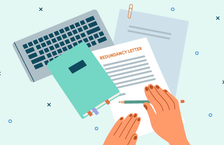No one wants to have to make an employee redundant. It’s not a pleasant thing to have to do, and you know it isn’t going to be well received by the people who are going to lose their jobs. Therefore, it’s vital that you understand the steps and legal responsibilities involved in a redundancy process, including how to inform employees via a redundancy letter.
Stick with us to learn how to write a redundancy letter, what to include and the steps for doing it in a way that meets legal obligations and in a way that has your staff’s interests at the center.
What is a redundancy letter?
A redundancy letter is an official document to notify staff of redundancy proceedings. It is the law to keep employees properly informed by letter at each stage of the redundancy process, but it’s also important not to rely on this process entirely. Speaking to employees and being open and honest about the proceedings will mean that the process will hopefully be more amicable and smooth. The letters do not need to be your only form of communication.
A redundancy letter should inform employees that their role is ending and why. There needs to be a valid reason as to why a role is ending, such as organizational change, or an end to necessary funding.
Types of redundancy letters
It’s important that an employer keeps employees informed at each stage of the redundancy process. With this in mind, there are three types of redundancy letter, which will be issued at each stage of the process.
- Job at risk of redundancy letter — This is the first official letter, which warns staff of potential redundancies looming within the company.
- Redundancy consultation letter — This letter invites individual employees to come for a meeting where options are discussed as part of the consultation process.
- Notice of redundancy — This letter is sent to employees who have been selected for redundancy and provides notice of their dismissal.
What to include in a redundancy letter
The letters will be different at each stage of the process, but there are essential points that need to be included according to the law and your HR policies. Making sure the letters are clear and explain the situation means there will be fewer enquiries, disagreements and danger of miscommunication further down the line. As a collective, your redundancy letters should include:
- The purpose of the letter — Introduce the reason for writing by summarizing the situation. The purpose of the letter must be crystal clear to avoid any confusion.
- The reason for redundancy — It is a legal requirement that you give a good reason for a redundancy. Otherwise, your employees can claim unfair dismissal.
- Address other options — It’s important to show that you are on the side of your employees and that you have done everything reasonably possible to keep them. This may include moving them into other roles or going into redeployment. The letter needs to state that these things have been considered and discussed.
- State the redundancy notice period — You are required to give notice of redundancy and give your employees a confirmed employment end date in writing. You should also include details of any payment in lieu of notice, and how remaining annual leave and bonuses will be handled, as well as including a date for an exit interview (if applicable).
- Address employee rights — Employees must be kept up to date at all stages of the process and their rights must be made clear, including their right to appeal and how to do that.
Steps to writing a redundancy letter
Use these steps to guide you through the process of writing your redundancy letter to ensure everything is covered so there are no grounds for wrongful termination, and so that your employees have all the information they need to understand and to navigate the process.
Step 1: Address the letter directly
Keep it personal. There are likely to be a number of people receiving a letter with the same content, but it’s still really important to address the letter to each individual employee, so that it is clear that information in the letter affects them personally. The letter should also contain the company’s address and contact details, as well as the date it was sent.
Step 2: Outline the purpose of the letter
It’s unlikely that your letter will be news to your employees. There should have been discussions and meetings leading up to this point, but it’s still important to outline the purpose of the letter. This needs to be done at the start as an introduction and to set the scene for what’s to come.
Step 3: Outline the reasons for redundancy
The second paragraph should spell out the reasons for redundancy. This is important, because if the reason isn’t good enough, an employee can claim unfair dismissal. There are a number of different reasons why you might be losing employees to redundancy, but you have to state yours clearly. It is a good idea to make clear in this section of the letter that you are regretful and losing staff is always a last resort.
Some reasonable reasons for redundancy could be that the role is no longer needed, the business is closing, or that the work is being completed by a new system or role in the company.
Step 4: Outline other options
It’s likely that you have discussed other options with your employees, such as moving to a new role or going into redeployment. Whatever the outcome of those discussions, detail them here as evidence that you have done all that you can to keep your staff in employment.
Step 5: State redundancy notice period
You must give a notice period and official date for the termination of employment. This is vital, so that employees know when they will be leaving and how much time they have to search for a new role.
Step 6: Address potential questions about payment and holiday
Make it clear whether your employee can expect to receive redundancy pay or any payment in lieu of annual leave. This can be documented alongside the notice period details. If your company is in the UK, the gov.uk website has a calculator that will give you the correct redundancy pay details. In this section, you’ll also address the process with any health insurance or other company benefits, along with what employee’s should do with any company property.
Step 7: Outline an employee’s right to appeal
It is acceptable for employees to appeal your decision and it’s up to you to let them know their rights and dates by which they must launch their appeal. Keeping employees up to date as the redundancy process happens and making them aware of their rights at every stage shows you are on their side and regretful about the situation.
Redundancy letter example
Writing a redundancy letter comes with a lot of considerations and extra effort to tick all the legal boxes. We know it’s not easy. So, we’ve put together an example letter for you to use and tweak to suit your needs:

Key takeaways
Making redundancies is not something any business wants to face, and it’s not a situation employees want to see themselves in either. It can result in stress, upset and bad feeling, which may not be pleasant, especially if it means appeals. It’s important that employees are kept up to date at every step of the process with redundancy letters or any other formal communications to avoid this, so it’s worth preparing HR templates for different situations that may arise. That way, when/if the time comes, you’ll be ready.
The most important points to follow when writing your redundancy letters is:
- Give a valid reason for redundancy proceedings and express regret.
- Include a redundancy notice period.
- Provide alternative options going forward.
- Express the right to appeal.
Here's to hoping you never have to make employees redundant. But, if you do, you'll be prepared.
Make sure to share this with your colleagues — you never know who might need some guidance.

